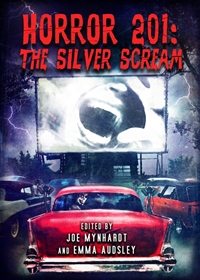
Edited by Joe Mynhardt and Emma Audsley
Crystal Lake Publishing
November 10, 2015
Reviewed by William Grabowski
Horror 201 is the kind of book I devour in one sitting, and—like eating or drinking oneself out of supplies—regret doing so at such a pace. But I can’t help it. This densely packed volume thrilled me as much as long-ago fare like The Zombies That Ate Pittsburgh and effects-master Tom Savini’s Grande Illusions. Editors Mynhardt and Audsley have assembled interviews, stand-alone pieces, and Fun Facts by and about selected screenwriters, filmmakers, authors and editors. Director Wes Craven gives one of his final interviews, and is remembered by several contributors. Ramsey Campbell’s tribute is especially pointed, and includes perhaps the most incisive summation yet written on Last House on the Left: “Besides being one of the first and most important of the horror films about the contemporary family, Last House on the Left anticipates and criticises the anti-feminist trend in horror films (‘You been reading those creep women’s lib magazines?’ Brenda is asked) and serves as a riposte to the urban revenge movies of the later seventies. It was among the last of the so-called video nasties to be banned in Britain, but was finally passed uncut (having previously been allowed with cuts) in March 2008.” Craven himself shares this: “The first proposal I wrote for A Nightmare on Elm Street—which dealt with Freddie being returned to life as a human—wasn’t approved by New Line Cinema because they said having Freddie being alive again brought up the specter of him being a child molester when he was human, and they didn’t want to remind [movie-goers] of that aspect of his character.”
Among the better-known interviewees—Romero, Carpenter, Tom Holland, Mick Garris—are profiles of equally interesting Lynne Hansen, Ed Naha, Harry Shannon and others. The information-monger in me dug into the various Fun Facts: the first “found-footage” movie was Cannibal Holocaust (1980). And how about this one? Before leaving Columbia Records, Ed Naha oversaw the legal clearances and engineering of the record that was placed in the Voyager spacecraft. In the words of the late Johnny Carson, “I did not know that.”
As the author of two screenplay novelizations, I found “Tricks of the Trade: Novelizations” informative and entertaining, with responses from Graham Masterton, Jonathan Maberry, Armand Rosamilia, Ed Naha, and Tim Waggoner. Along these lines are screenwriting tips (and assorted tidbits on the industry) from Night of the Living Dead co-author John Russo, Denise Gossett, Edward Lee, Jeff Strand, Jason V. Brock, my Cleveland homeboy David Henson Greathouse, and more.
For those (like me) with a scholarly bent, there is “The Evolution of the Horror Film & Viewer Desensitization,” by David C. Hayes, MS, MFA; and “Horror Is Culture, or The Cloverfield Monster is Osama bin Laden” by Kevin Wetmore. These are no fluff pieces, but well-researched and insightful perspectives by two writers with obvious love for the genre.
If read in moderation, Horror 201 will expertly guide you through silent snowy nights—assuming we have any!








